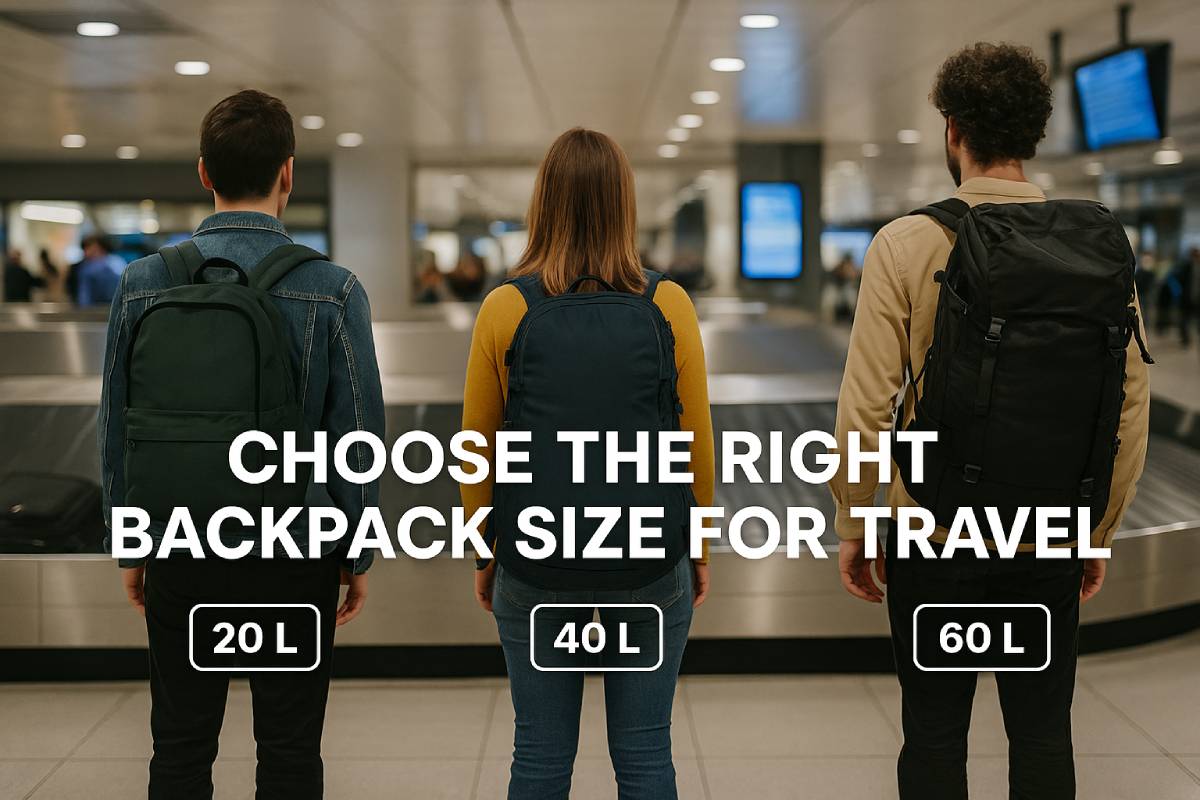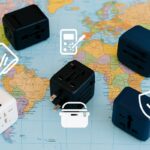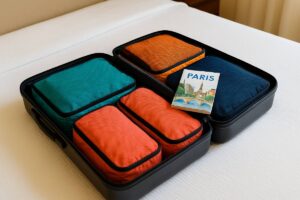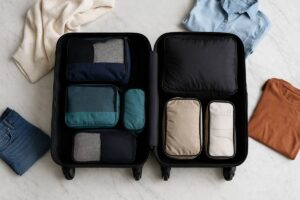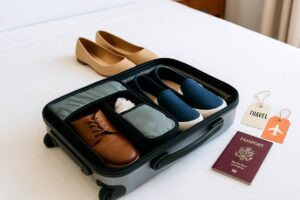Selecting the perfect backpack volume is crucial for comfort, organization, and meeting airline regulations.
Backpack capacity, measured in liters, directly translates to gear volume—15 L holds essentials, while 45 L accommodates a week’s worth of clothing and tech.
Proper fit, achieved by measuring torso length and adjusting straps, transfers roughly 80 % of weight to the hips, minimizing fatigue on extended journeys.
Seasonal demands—from compressible down jackets to quick-dry garments—require tools like compression sacks that reduce bulk by up to one-third.
Aligning pack size with trip length and carrier limits ensures a smooth, stress-free travel experience.
Understanding Backpack Capacity
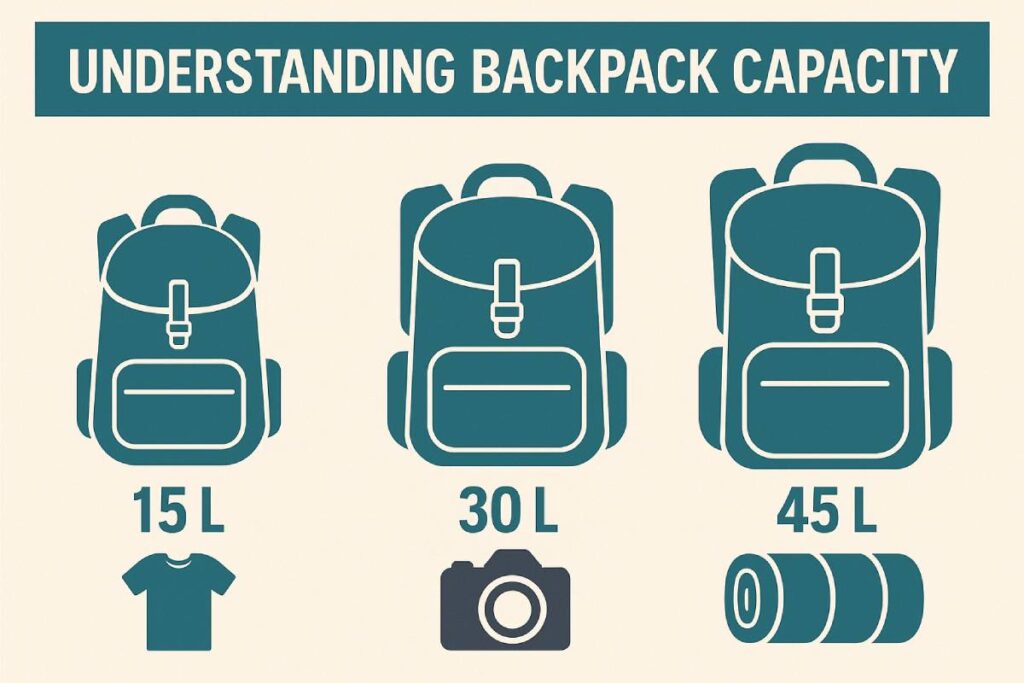
Backpack capacity isn’t just a number—it’s the key to balancing how much gear you carry, how comfortably you carry it, and whether it meets airline rules. Capacity is measured in liters following industry standards (ASTM F2153-07), with one liter roughly equating to the volume of a rolled cotton T-shirt or two 500 mL water bottles. Most U.S. airlines cap carry-on baggage at 22 × 14 × 9 inches (56 × 36 × 23 cm) with an under-seat personal item up to 18 × 14 × 8 inches (46 × 36 × 20 cm), while European low-cost carriers like Ryanair restrict personal bags to 40 × 20 × 25 cm and overhead bags to 55 × 40 × 20 cm (with priority purchase). Common pitfalls—choosing an oversized pack, ignoring proper fit, or skimping on weight distribution—can lead to overpacking, discomfort, and inefficient hikes, often increasing energy expenditure by up to 15 %.
Liters and Dimensions
Backpack size is expressed by its internal volume in liters, measured by filling all compartments with standardized material and dumping into a graduated cylinder per ASTM F2153-07. To visualize this volume, imagine the “T-shirt rule of thumb”: one liter roughly equals the space a rolled men’s large cotton T-shirt occupies, and a 30 L pack holds about 60 standard 500 mL water bottles’ worth of volume. <table> <thead> <tr> <th>Backpack Size</th> <th>Liters</th> <th>Cubic Inches</th> <th>Typical Use</th> </tr> </thead> <tbody> <tr> <td>Daypack / Small</td> <td>15 – 24 L</td> <td>915 – 1 465 in³</td> <td>City sightseeing, errands, 1-night trips :contentReference[oaicite:6]{index=6}</td> </tr> <tr> <td>Medium</td> <td>24 – 35 L</td> <td>1 465 – 2 135 in³</td> <td>2-3 day trips, laptop & work gear :contentReference[oaicite:7]{index=7}</td> </tr> <tr> <td>Large</td> <td>30 – 45 L</td> <td>1 830 – 2 746 in³</td> <td>3-4 day travels, extra layers :contentReference[oaicite:8]{index=8}</td> </tr> </tbody> </table>
Carry-On vs. Checked Baggage
Airline carry-on rules vary, but in the U.S. most major carriers limit bags to 22 × 14 × 9 inches (56 × 36 × 23 cm) including wheels and handles, with total linear dimensions not exceeding 45 inches. Every passenger can also bring one personal item—up to 18 × 14 × 8 inches (46 × 36 × 20 cm)—that must fit under the seat in front of you. In Europe, Ryanair’s policy allows a free small personal bag (40 × 20 × 25 cm) and, with Priority & 2 Cabin Bags, a 55 × 40 × 20 cm overhead bag (10 kg max). Always confirm your specific airline’s dimensions before departure to avoid last-minute fees or gate check-ins.
Common Sizing Mistakes
- Overestimating Capacity: Choosing a pack that’s “just in case” large often leads to hauling unnecessary items and extra weight. A bag that’s too big invites overpacking, making your load cumbersome and potentially exceeding airline size or weight limits.
- Ignoring Proper Fit: Many travelers select backpacks purely by volume without measuring torso length or testing strap adjustments. A pack that doesn’t match your torso length or lacks proper strap tuning can cause shoulder pain and reduce stability.
- Neglecting Weight Distribution: Unevenly distributed loads can increase energy expenditure by up to 15 % and strain your back and shoulders. Failing to use hip belts and load-lifters correctly prevents 60–80 % of the weight from transferring to your hips, undermining comfort and endurance.
By understanding how liters translate to real-world gear volume, adhering to airline baggage rules, and avoiding these common pitfalls, you’ll choose a backpack that’s the perfect size for your next adventure—light on your back and fully compliant with travel regulations.
Selecting by Trip Duration
Backpack size should align with your trip length: a compact 15–30 L pack is ideal for quick weekend escapes, fitting core essentials without weighing you down; for one-week journeys, 30–45 L balances clothing, toiletries, and tech; and extended travels often demand 45–70 L (or more) to accommodate bulkier gear and seasonal layers. Choosing the right volume streamlines your packing process, prevents overstuffing, and ensures comfort on the trail or in the terminal—setting you up for a stress-free adventure.
Weekend Getaways (15 – 30 L)
For 1–3 night trips, a 15–30 L daypack keeps things light and nimble, perfect for city breaks or short hikes. Embrace minimalist packing by focusing on versatile, quick-dry fabrics and mix-and-match pieces. Rolling garments and using one or two compression cubes maximizes space while preventing wrinkles. <table> <thead> <tr> <th>Item Category</th> <th>Examples for 15–30 L Pack</th> </tr> </thead> <tbody> <tr> <td>Clothing</td> <td>2 T-shirts, 1 long-sleeve top, 1 pair of shorts/jeans, light jacket</td> </tr> <tr> <td>Toiletries</td> <td>Travel-size shampoo, toothpaste, deodorant, sunscreen</td> </tr> <tr> <td>Essentials</td> <td>Wallet, phone, chargers, reusable water bottle</td> </tr> <tr> <td>Packing Aids</td> <td>1 compression cube, small drawstring laundry bag</td> </tr> </tbody> </table>
One-Week Journeys (30 – 45 L)
A 30–45 L pack accommodates 5–7 days of clothing plus toiletries and electronics without bulk. Balance your load by limiting outfits to a capsule wardrobe (e.g., 4 tops, 2 bottoms) and packing travel-size hygiene products. Allocate dedicated pockets or cubes for cables, power banks, and noise-canceling earbuds to keep gadgets organized and accessible. <table> <thead> <tr> <th>Section</th> <th>Contents</th> </tr> </thead> <tbody> <tr> <td>Clothing</td> <td>4 tops, 2 bottoms, 1 lightweight sweater, underwear & socks for 7 days</td> </tr> <tr> <td>Toiletries</td> <td>Travel-size kit: shampoo, conditioner, body wash, razor, toothbrush</td> </tr> <tr> <td>Electronics</td> <td>Phone, charger, laptop/tablet, cables, power bank, adaptors</td> </tr> <tr> <td>Packing Aids</td> <td>2 compression cubes, cable organizer, toiletry pouch</td> </tr> </tbody> </table>
Extended Travels (45 – 70 L+)
For trips beyond a week or adventures in variable climates, 45–70 L packs offer room for bulkier gear—like extra layers, a sleeping bag, or cooking kit. Consider a model with a detachable daypack (e.g., 60 L main + 20 L daypack) for flexibility on side-trips. When venturing into colder regions or high altitudes, reserve space for insulated jackets, thermal base layers, and waterproof shells. <table> <thead> <tr> <th>Gear Category</th> <th>Items for 45–70 L Pack</th> </tr> </thead> <tbody> <tr> <td>Clothing & Layers</td> <td>Thermal set, insulated jacket, fleece, waterproof shell, extra socks</td> </tr> <tr> <td>Equipment</td> <td>Sleeping bag, compact stove, headlamp, first-aid kit</td> </tr> <tr> <td>Toiletries & Misc.</td> <td>Larger toiletry kit, multi-tool, sun/lip balm, reusable utensils</td> </tr> <tr> <td>Daypack</td> <td>Detachable 15–20 L pack for excursions</td> </tr> </tbody> </table> ::contentReference[oaicite:9]{index=9}
Ensuring Proper Fit and Comfort
Proper backpack fit is the foundation of comfort and endurance on the trail or during travel. Accurately measuring your torso length ensures the harness aligns with your spine, preventing shoulder strain and maximizing stability. A well-adjusted hip belt transfers roughly 80 % of your pack’s weight to the hips—leveraging the strongest muscles in your body—and can reduce perceived effort by up to 25 %. Finally, ergonomic shoulder straps, padded back panels, and ventilated suspension systems keep you cool and distribute pressure evenly, cutting hot-spot formation and muscle fatigue on long hauls.
Measuring Torso Length
- Stand Tall & Neutral: Adopt an upright posture with feet shoulder-width apart, shoulders relaxed, and head facing forward—no leaning or hunching.
- Locate Landmarks: Find the C7 vertebra at the base of your neck (the most prominent bone when you tilt your head forward) and the iliac crest of your hipbones.
- Measure the Distance: With a friend’s help, use a flexible tape to measure in a straight line from C7 down your spine to the horizontal line between your thumb tips when arms hang naturally—this is your torso length in inches or centimeters.
- Match to Pack Sizing: Refer to manufacturer charts—most torso lengths fall between 14″ and 21″—and choose a pack model sized or adjustable to your measurement.
Hip Belt and Load Distribution
A properly fitted hip belt shifts the load off your shoulders onto your pelvis and legs:
- 80 / 20 Rule: Aim to have about 80 % of pack weight on your hips and 20 % on your shoulders.
- Adjustment Steps: Center the belt on your iliac crests, tighten snugly (you should feel most weight on hips), then adjust load-lifters (angled straps above shoulders) to bring the pack body close to your back.
- Performance Gain: This distribution can lower perceived hiking difficulty by up to 25 %, reducing muscle fatigue and strain.
| Metric | Value |
|---|---|
| Weight on Hips | 80 % |
| Weight on Shoulders | 20 % |
| Reduced Perceived Effort | Up to 25 % |
Strap, Padding, and Ventilation Features
- Shoulder Straps: Look for high-density foam or molded sections that cushion heavy loads, reducing pressure points over prolonged wear.
- Back Panels & 3D Channels: Mesh-covered foam ridges create airflow gaps between your back and the pack, enhancing breathability and moisture wicking on hot days.
- Ventilated Suspension: A suspended mesh frame or “air-flow” design can lower back sweat and improve thermoregulation, critical for multi-day hikes in warm climates.
By combining precise torso measurements, optimal hip-belt setup, and advanced strap and ventilation systems, you’ll enjoy a backpack that feels like an extension of your body—supporting you comfortably mile after mile.
Navigating Airline Restrictions
Navigating airline baggage rules can feel like decoding a secret language, but understanding size limits is crucial to avoid extra fees and gate-check surprises. In the U.S., American, United, and Delta all follow the Federal Aviation Administration standard of 22 × 14 × 9 inches (56 × 36 × 23 cm) for carry-ons, with personal items typically capped at roughly 18 × 14 × 8 inches (46 × 36 × 20 cm).
Budget carriers like Ryanair limit non-priority fliers to a single small bag of 40 × 20 × 25 cm (15.7 × 7.9 × 9.8 inches) and let Priority passengers add a 55 × 40 × 20 cm (21.7 × 15.7 × 7.9 inches) cabin bag (10 kg max), while EasyJet’s free under-seat allowance is 45 × 36 × 20 cm (17.7 × 14.2 × 7.9 inches). Globally, the de facto standard remains around 56 × 36 × 23 cm (22 × 14 × 9 inches) for cabin bags. Smart travelers combine a streamlined under-seat item with a compliant backpack—packed with compression cubes and bulkiest layers worn onboard—to maximize capacity while staying within dimensions.
Major U.S. Carriers
American Airlines allows one carry-on up to 22 × 14 × 9 inches (56 × 36 × 23 cm) and one personal item (purse, small backpack) up to 18 × 14 × 8 inches (45 × 35 × 20 cm).
United Airlines likewise permits a single carry-on of 22 × 14 × 9 inches (56 × 35 × 23 cm) that must fit in the overhead bin, plus one under-seat personal item (no strict published size but expected to fit beneath the seat).
Delta Air Lines enforces a 22 × 14 × 9 inch (56 × 35 × 23 cm) maximum for carry-ons, and allows one personal item that must fit under the seat.
| Airline | Carry-On Limit (L×W×H) | Personal Item Limit (L×W×H) |
|---|---|---|
| American Airlines | 22 × 14 × 9 in (56 × 36 × 23 cm) | 18 × 14 × 8 in (45 × 35 × 20 cm) |
| United Airlines | 22 × 14 × 9 in (56 × 35 × 23 cm) | Fits under seat (no published size) |
| Delta Air Lines | 22 × 14 × 9 in (56 × 35 × 23 cm) | Fits under seat |
Budget and International Airlines
Ryanair’s non-priority passengers may bring only a small bag (40 × 20 × 25 cm; 15.7 × 7.9 × 9.8 inches) under the seat. Priority ticket holders add a 55 × 40 × 20 cm (21.7 × 15.7 × 7.9 inches) overhead cabin bag (max 10 kg).
EasyJet offers every passenger a free under-seat bag of up to 45 × 36 × 20 cm (17.7 × 14.2 × 7.9 inches), with Up Front/Extra Legroom bookings or EasyJet Plus holders allowed an additional larger cabin bag (max 56 × 45 × 25 cm).
Most international carriers align with a 56 × 36 × 23 cm (22 × 14 × 9 inches) standard for cabin luggage, though weight caps and personal item rules vary by region.
| Airline | Small/Personal Bag | Cabin Bag | Weight Limit |
|---|---|---|---|
| Ryanair | 40 × 20 × 25 cm (15.7 × 7.9 × 9.8 in) | 55 × 40 × 20 cm (21.7 × 15.7 × 7.9 in) | 10 kg |
| EasyJet | 45 × 36 × 20 cm (17.7 × 14.2 × 7.9 in) | 56 × 45 × 25 cm (22 × 18 × 10 in) | 15 kg (under seat) |
| Global Standard | N/A | 56 × 36 × 23 cm (22 × 14 × 9 in) | Varies |
Personal Item Strategies
- Dual-Layer Packing: Use your personal-item allowance for a structured backpack (e.g., 18 × 14 × 8 inches) filled with daily essentials—wallet, electronics, a fresh shirt—and reserve the under-seat bag for dirty laundry or heavier items.
- Compression & Organization: Employ packing cubes in both bags to compress clothing and segregate gear—minimizing wasted space and easing security screening.
- Wear Bulky Items: Don your bulkiest layers or shoes onboard to free up internal volume and balance weight distribution between carry-on and personal-item bags.
By mastering each carrier’s size limits and combining a compliant backpack with an under-seat companion, you’ll travel lighter, avoid fees, and keep essentials close at hand—turning baggage restrictions from a headache into a streamlined part of your journey.
Practical Packing and Seasonal Considerations
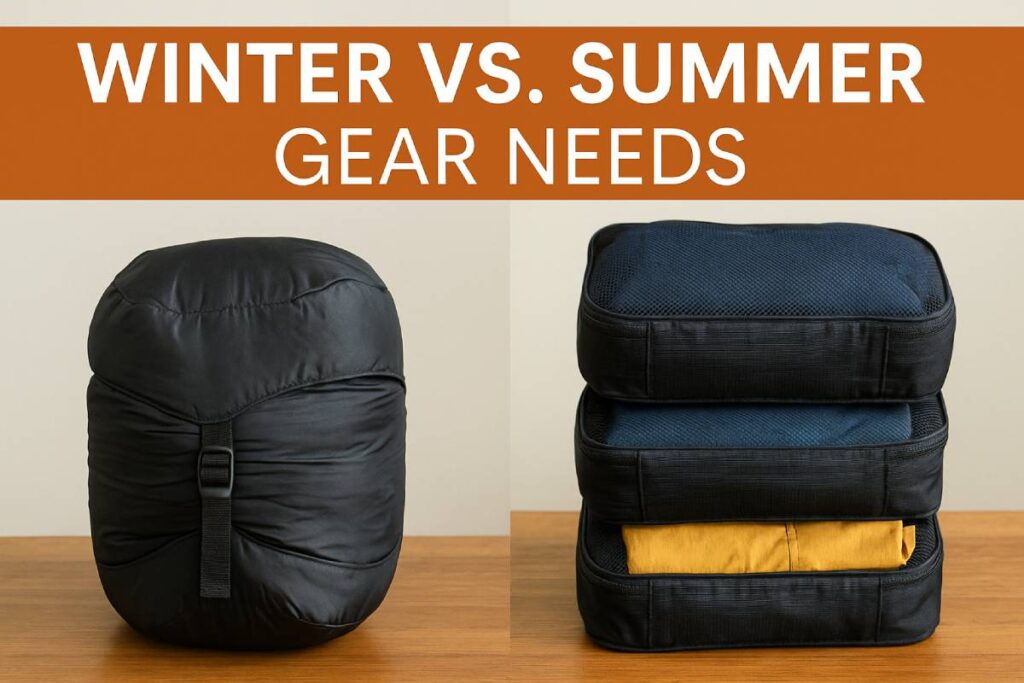
Before you zip up, remember that what you pack—and how you pack—will change dramatically with the season and your pack’s volume. Winter trips demand warm, insulating layers that can bulk out your bag unless you use compression sacks, while summer journeys lean on lightweight, quick-dry fabrics that often slip into a 25 L daypack without issue. Below, you’ll find tailored sample packing lists for 25 L, 40 L, and 60 L backpacks, plus expert tips on maximizing space and comfort with rolling techniques, packing cubes, and strategic layering.
Winter vs. Summer Gear Needs
Insulation Layers vs. Compressible Items
- Base–Mid–Shell Layering: A classic three-layer system lets you regulate temperature: a moisture-wicking base, an insulating mid-layer (fleece or down), and a waterproof shell.
- Bulky vs. Compressible: Down jackets and sleeping bags can be squeezed into lightweight compression sacks—often cutting volume by up to 50 %—whereas synthetic or fleece layers resist extreme compression.
- Seasonal Sizing Rule: For winter, plan on adding 10–15 L of extra space over your summer pack to accommodate thicker layers and bulkier accessories like gloves, hats, and insulated boots.
| Season | Key Gear | Packing Strategy |
|---|---|---|
| Winter | Down jacket, fleece, thermal baselayer, insulated boots | Use compression sacks for down; wear bulkiest items on plane |
| Summer | Quick-dry T-shirts, lightweight shorts, sun hat, sandals | Roll garments; choose mesh-panel backpacks for ventilation |
Packing Lists by Backpack Size
25 L Pack (Weekend & Day Trips)
A 25 L bag handles a 1–3 night excursion when you stick to the essentials and use minimalist techniques.
| Category | Items |
|---|---|
| Clothing | 2 T-shirts, 1 long-sleeve top, 1 pair of shorts/jeans, underwear & socks |
| Outer Layer | Lightweight windbreaker or rain shell |
| Footwear | Single pair of travel-comfortable shoes |
| Toiletries | Travel-size kit (shampoo, toothpaste, deodorant) |
| Extras | Phone, charger, small first-aid kit, reusable water bottle |
(Based on a Reddit one-bag setup for 25 L packs)
40 L Pack (One-Week Journeys)
A 40 L bag strikes balance between enough clothes for 5–7 days and room for electronics.
| Category | Items |
|---|---|
| Clothing | 4 tops, 2 bottoms, 1 sweater, 7 pairs of underwear & socks |
| Outer Layer | Compact puffer or rain jacket |
| Footwear | One pair sneakers + optional lightweight sandals |
| Toiletries | Travel-size shampoo, conditioner, body wash, razor |
| Electronics | Phone, charger, tablet/laptop, cables, power bank |
| Packing Aids | 2 compression or organizational cubes |
(Adapted from a blog on packing for Europe with a 40 L backpack)
60 L Pack (Extended & Seasonal Trips)
When you need space for a sleeping bag, extra layers, and gear for variable climates, aim for 60–70 L.
| Category | Items |
|---|---|
| Clothing | Thermal base layers, fleece mid-layer, insulated jacket, 2–3 bottoms, 7–10 underwear & socks |
| Equipment | Sleeping bag, compact stove, cooking kit, headlamp |
| Outerwear | Waterproof shell, packable down jacket |
| Footwear | Hiking boots + camp shoes |
| Toiletries | Full-size kit (shampoo, soap, first-aid, repair kit) |
| Daypack | Detachable 15–20 L pack for daily excursions |
(Based on ultralight community practices for 60 L backpacks).
Efficiency Tips
Rolling vs. Folding
- Edge-to-Edge Packing: Rolling clothes can fill nooks but may leave gaps; flat “bundle” folding often yields fewer dead zones and more uniform compression.
- Hybrid Approach: Roll small items (socks, underwear) and bundle large garments flat to maximize space.
Packing Cubes
- Organizational Power: Cubes segment clothing by type, speed up security checks, and protect fabrics from dirt.
- Compression Models: Dual-zipper cubes can shrink bulky items—jackets or sweaters—by up to 30 % in volume.
Layering Techniques Inside Your Pack
- Weight Pyramid: Place heavy items (shoes, stove) close to your back and center, lighter clothing toward the outer and top sections.
- Easy-Access Layers: Store rain gear or insulated shells in top or hip-belt pockets for quick retrieval.
By matching your pack size and organization methods to trip length and season, you’ll travel lighter, stay organized, and keep gear exactly where you need it—whether you’re chasing sunlit trails or snowy peaks.
Brand and Model Recommendations
Here are my top brand and model recommendations for 2025, covering premium picks, budget-friendly alternatives, and specialty fits to suit every traveler’s needs.
In 2025, travel backpacks span a wide spectrum—from modular, sustainable designs like the Cotopaxi Travel Pack 42 L with air-mesh straps and recycled materials to tech-focused options such as the Peak Design Travel Backpack 45 L featuring configurable FlexFold dividers and RFID-safe pockets. Premium adventure packs like the Away Active Convertible 45 L offer clamshell access and duffel handles for $220, while compression specialists like the Tropicfeel Shell Backpack adjust from 20 L to 42 L and include a removable wardrobe organizer for $239.
Budget travelers can choose under-$100 workhorses such as the Asenlin 40 L at $37 or tomtoc’s TSA-friendly 40 L pack at $87.99. Those with specific needs will find women-specific cuts in the Osprey Fairview 40 L, designed for female anatomy and lifetime-warranty reliability, ultralight performance in the ULA Ultra Circuit (68 L, 33.8 oz), and technical organization in the Peak Design carry-on.
Top Travel Backpacks of 2025
Below are standout premium picks—ideal for frequent flyers, digital nomads, and adventure seekers.
| Model | Volume | Key Features | Price |
|---|---|---|---|
| Cotopaxi Travel Pack | 42 L | Recycled nylon, air-mesh straps, luggage pass-through, water-resistant | $168 |
| Away Active Convertible Backpack | 45 L | Clamshell access, duffel handles, cushioned straps, laptop sleeve | $220 |
| Tropicfeel Shell Backpack | 20–42 L | Adjustable volume, compressing wardrobe organizer, sustainable fabric | $239 |
| Peak Design Travel Backpack | 45 L | FlexFold dividers, RFID pockets, weather-resistant shell | $300 |
Budget-Friendly Alternatives
Great performance without breaking the bank—perfect for one-bag travelers and underseat carry-on strategies.
| Model | Volume | Price | Notes |
|---|---|---|---|
| Asenlin Travel Backpack | 40 L | $37 | Includes 3 packing cubes; durable nylon |
| tomtoc TSA-Friendly Pack | 40 L | $87.99 | Flight-approved, water-resistant, fits 17.3″ laptop |
| Fjällräven Räven 20 | 20 L | ≈$100 | Eco-friendly G-1000 fabric, slim profile |
| B&M Bordlite Underseat Bag | ~20 L | £7 | Fits under most seats (40×25×20 cm), ideal for no-fee carry-on |
Specialty Fits
Women-Specific Cuts
Osprey Fairview 40 L – Tailored suspension, adjustable hip-belt and sternum straps, lifetime warranty; praised for comfort on long itineraries and weekend escapes.
Ultralight Styles
ULA Ultra Circuit 68 L – Weighs just 33.8 oz (2.1 lb) for 68 L capacity, carbon-fiber hoop frame, minimal design for fast-packing journeys.
Technical Packs
Peak Design Travel Backpack 45 L – Innovative FlexFold divider system adapts for camera gear or apparel, RFID-safe pockets, weatherproof exterior, works as carry-on and tech bag.
By matching your itinerary—whether city hopping, week-long escapes, or off-grid treks—with one of these curated picks, you’ll enjoy streamlined packing, ergonomic comfort, and peace of mind under any sky.
Interactive Tools and Visual Aids
Interactive tools and visual aids transform backpack selection and packing from guesswork into a precise, stress-free process. Online calculators like Calculator Academy’s Backpack Capacity Calculator let you input your pack’s length, width, and height to instantly determine its liter volume—eliminating manual math and ensuring you pick a bag that fits your needs.
Advanced calculators, such as Orient Bag’s guide, improve on the simple L×W×H formula by using an elliptical-cylinder method to approximate irregular shapes, reducing volume overestimation by 20–40 % Visual sizing charts—like Backpackies’ infographic mapping Small (under 19 L), Medium (20–29 L), and Large (30–39 L) categories—provide at-a-glance guidance on which sizes suit day trips, weekend getaways, and longer adventures.
Finally, downloadable packing checklists from expert sources (e.g., REI’s Backpacking Checklist PDF, Travel Preparation Checklist) offer printer-friendly lists organized by trip length and type, ensuring you pack efficiently and never overlook core gear.
Backpack Size Calculator
Online calculators automate volume conversion and help personalize your pack choice:
| Tool | Method | Notes | Source |
|---|---|---|---|
| Calculator Academy Backpack Capacity | L×W×H ⁄ 1000 → Liters | Simple input of external dimensions | calculator.academy |
| Orient Bag Volume Calculator | Elliptical cylinder formula (π·a·b·h) | More accurate for non-box shapes | orientbag.net |
| Crea India Bag Capacity Calculator | L×W×H → cm³ ⁄ 1000 → Liters | Multi-unit support (cm/in/ft) | creaindia.com |
These tools eliminate guesswork, letting you enter your pack’s dimensions in centimeters, inches, or feet and instantly see the internal volume in liters—critical for matching your pack to trip duration and gear needs.
Visual Sizing Chart
Infographics map liter ranges to real-world use cases and dimensions, making size selection intuitive:
| Size Category | Liters | Typical Use | Example Chart Source |
|---|---|---|---|
| Small (Under 19 L) | 0–19 L | Daily carry, tech essentials, short hikes | Backpackies Ultimate Guide |
| Medium (20–29 L) | 20–29 L | Day hikes, 1–3 night trips, students | The Pedal Project Guide |
| Large (30–39 L) | 30–39 L | Weekend getaways, city travel | Knack Bags Comprehensive Guide |
| Expedition (40+ L) | 40 L+ | Extended/backpacking trips | Nomads Nation Size Explained |
Such charts typically illustrate pack silhouettes overlaid with volume buckets, helping you visualize what fits inside each size and preventing over- or under-buying.
Downloadable Packing Checklist
Printer-friendly PDFs streamline packing and reduce omissions:
| Checklist Name | Format | Trip Type | Source |
|---|---|---|---|
| REI Backpacking Checklist | PDF (13 × 19 in printable) | Multi-day/backcountry backpacking | rei.com |
| REI Travel Preparation | PDF timeline (10–30 days out) | Pre-trip planning | rei.com |
| REI Ultralight Backpacking | PDF (1 page) | Ultralight hiking | rei.com |
| Canva Travel Infographic | Editable infographic template | Custom packing visuals | canva.com |
- REI’s Backpacking Checklist covers gear from shelter to cooking systems, customizable per trip length and conditions.
- Travel Preparation Checklist orders tasks and gear by timeline (10–30 days, 5–7 days, and 1 day before) to keep logistics on track.
- Ultralight Backpacking Checklist focuses on minimalist gear systems to maximize mobility and efficiency.
- Canva’s Travel Infographics let you design and print custom charts or packing layouts to match your style and trip specifics.
By combining personalized calculators, clear visual charts, and tailored checklists, you’ll choose the perfect backpack size, pack strategically for any season, and travel confidently—knowing you’ve covered every essential.
Real Traveler Insights
Minimalist travelers consistently demonstrate that you can journey comfortably with ultra-small packs—going as low as 16 L by choosing a clamshell-opening bag like the Fjällräven Kånken Original and pairing it with a compact day bag for urban outings. Stepping up to a 30 L pack, professionals and digital nomads fit business attire, electronics, and a few spare garments into carry-on compliance, exemplified by the Peak Design Travel Backpack 30 L.
Yet many fall into the overpacking trap, stashing “just in case” items and specialty gear they never use—resulting in bulky bags, extra fees, and back strain. Experts warn that failing to establish a capsule wardrobe and overloading toiletries often leads to unnecessary bulk, turning travel into a logistical headache. To avoid these pitfalls, seasoned packers advocate the “live out of it” test—using only the items you’ve packed for a trial run at home—and leveraging packing cubes to compress and organize gear for smoother, lighter adventures.
Minimalist Packing Testimonials
16 L Setups
- Fjällräven Kånken Original, 16 L: A long-time favorite among city slickers, this minimal pack’s clamshell design holds two rolled T-shirts, a lightweight rain shell, and essentials—proof you don’t need more than 16 L for a weekend in town.
- Timbuk2 Shadow, 16 L: Another success story comes from Carryology’s one-bag community, where travellers praise the Timbuk2 Shadow’s sleek profile (14.7 oz), water-resistant fabric, and enough room for a tablet, charger, snack, and a compact toiletry kit.
30 L Setups
- Peak Design Travel Backpack, 30 L: Pack Hacker users rave that this bag’s FlexFold divider system and clamshell access let them pack a blazer, two shirts, a tablet, and chargers—all while fitting airline carry-on limits.
- Bellroy Lite Travel Pack, 30 L: Business travellers on YouTube report fitting a day’s worth of work clothes, a laptop, toiletries, and a compact umbrella comfortably into 30 L, with quick-access pockets for boarding passes and phone chargers.
- First-Time 30 L Trial (Reddit): A user on r/onebag successfully completed a week-long cross-country trip with a 30 L carry-on, focusing on lightweight tech tees, a single pair of jeans, and doing laundry mid-week.
Lessons from Overpacking
Travel experts and seasoned backpackers identify several recurring mistakes—and the fixes that keep your load lean:
| Common Pitfall | Streamline Strategy | Source |
|---|---|---|
| Packing “Just in Case” specialty gear | Adopt a capsule wardrobe: versatile layers only | travel-bash.com |
| Overloading toiletries and cosmetics | Create a toiletry kit with travel-size essentials only | travel-bash.com |
| Ignoring the “live out of it” trial | Trial-run your packed list at home for one week | reddit.com |
| Neglecting packing cubes | Use compression cubes to organize and shrink items | realsimple.com |
| Failing to plan for laundry | Schedule mid-trip laundries and pack quick-dry fabrics | reddit.com |
- Mix and Match, Layers Are Key: Limiting yourself to multi-use pieces—two tops, one bottom, one jacket—prevents the “I might wear it once” trap.
- Test Before You Go: Packing everything, then living out of your bag for a few days highlights unused items to cut.
- Embrace Laundry Plans: Small loads of laundry in hotels or local laundromats free up space and lighten your daily carry.
- Learn from Pack It Right: RealSimple reports that overpacking commonly stems from anxiety over missing items—cultivating confidence in your essentials list is the antidote.
- Avoid the “Just in Case” Mentality: The New Yorker’s narrative on a disastrous overpacking experience underscores how discipline and minimalist principles turn packing from chore to art.
By studying real traveller successes with 16 L and 30 L packs and heeding overpacking warnings, you’ll develop a lean, efficient kit that carries only what you truly need—freeing you to focus on exploration instead of excess.
Conclusion
From quantifying pack volume in liters to fine-tuning harness adjustments, choosing the right backpack size is a step-by-step process that pays dividends in comfort and convenience. You start by translating liter specifications into real-world capacity—knowing that a 15 L daypack handles quick city breaks, while a 45 L pack is your go-to for week-long journeys.
Next, precise torso and hip measurements ensure that about 80 % of the load rests on your hips, cutting shoulder strain and fatigue on long walks. Summer adventures with quick-dry fabrics can squeeze into smaller packs, whereas winter trips demand compression sacks to tame bulky down layers. Matching pack size to trip duration—15–30 L for weekends, 30–45 L for one-week, and 45–70 L+ for extended expeditions—helps you avoid overpacking and surprise fees.
Finally, aligning your choice with airline carry-on regulations keeps you out of airport hassles. By weaving together these best practices—capacity mapping, fit precision, seasonal strategies, and compliance—you’ll step onto every journey with confidence, knowing your pack is as ready as you are.
FAQs
How do I measure my torso length for a backpack?
Use a flexible tape to measure from the C7 vertebra at your neck base down to the iliac crest at your hips—this is your torso length.
What size backpack do I need for a weekend trip?
A 15–30 L pack handles 1–3 nights: think 2–3 tops, 1 bottom, light jacket, and essentials in one compression cube.
How much weight should rest on my hips?
Aim for 80 % of your pack’s weight on your hips and 20 % on shoulders to reduce strain.
Can compression sacks really reduce bulk?
Yes—down and soft items can shrink by one-half to one-third in quality compression sacks.
What are standard U.S. carry-on dimensions?
Most U.S. airlines allow up to 22 × 14 × 9 in for carry-ons and an 18 × 14 × 8 in under-seat personal item.

